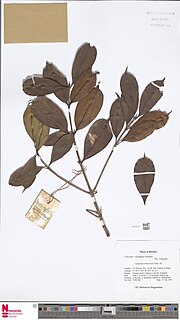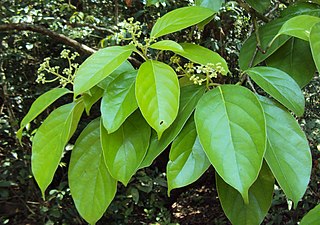
Cratoxylum arborescens is a plant in the family Hypericaceae. The specific epithet arborescens is from the Latin meaning "tree-like".

Cratoxylum maingayi is a plant in the family Hypericaceae. It is named for the botanist Alexander Carroll Maingay.
Maranthes corymbosa is a tree in the family Chrysobalanaceae. The specific epithet corymbosa is from the Greek meaning "cluster", referring to the clustered inflorescences.

Mastixia is a genus of about 19 species of resinous evergreen trees, usually placed in the family Cornaceae. Its range extends from India through Southeast Asia and New Guinea to the Solomon Islands. Mastixia species have alternate or opposite simple broad leaves, many-flowered inflorescences, and blue to purple drupaceous fruits.
Mastixia glauca is a tree in the family Nyssaceae. The specific epithet glauca is from the Greek meaning "bluish-grey", referring to the colour of the leaf underside.
Mastixia macrocarpa is a tree in the family Nyssaceae. The specific epithet macrocarpa is from the Greek meaning "large fruit".
Dysoxylum cyrtobotryum is a tree in the family Meliaceae. The specific epithet cyrtobotryum is from the Greek meaning "curved fruits".

Canarium hirsutum is a tree in the family Burseraceae. The specific epithet hirsutum is from the Latin meaning "bristly", referring to the rough hairs of the fruit.
Canarium merrillii is a tree in the family Burseraceae. It is named for the American botanist Elmer Drew Merrill.
Canarium denticulatum is a tree in the family Burseraceae. The specific epithet denticulatum is from the Latin meaning "small teeth", referring to the leaf margin.
Dacryodes incurvata is a tree in the family Burseraceae. The specific epithet incurvata is from the Latin meaning "bending inward", referring to the leaflet margin.
Dacryodes laxa is a tree in the family Burseraceae. The specific epithet laxa is from the Latin meaning "loose", referring to the inflorescence.
Dacryodes nervosa is a tree in the family Burseraceae. The specific epithet nervosa is from the Latin meaning "with nerves", referring to the leaves.
Dacryodes rugosa is a tree in the family Burseraceae. The specific epithet rugosa is from the Latin meaning "wrinkled", referring to the leaflets.
Mastixia cuspidata is a tree in the family Nyssaceae. The specific epithet cuspidata is from the Latin meaning "sharp-pointed", referring to the leaf apex.
Mastixia pentandra subsp. scortechinii is a subspecies of Mastixia pentandra. It is a tree in the family Nyssaceae. It is named for the botanist Benedetto Scortechini.
Mastixia rostrata subsp. caudatifolia is a subspecies of Mastixia rostrata. It is a tree in the family Nyssaceae. The infraspecific epithet caudatifolia is from the Latin meaning "tapered leaf".
Mastixia trichotoma is a tree in the family Nyssaceae. The specific epithet trichotoma is from the Greek meaning "three parts", referring to the three-branched inflorescence.

Cratoxylum glaucum is a plant in the family Hypericaceae. The specific epithet glaucum is from the Latin meaning "blue-green", referring to the colour of the leaf underside.
Engelhardia roxburghiana is a tree in the family Juglandaceae. It is named for the Scottish botanist William Roxburgh.




